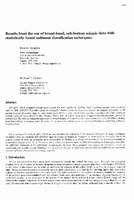| dc.contributor.author | Simpkin, Peter G. | |
| dc.contributor.author | Collins, William T. | |
| dc.date.accessioned | 2018-10-11T14:08:22Z | |
| dc.date.available | 2018-10-11T14:08:22Z | |
| dc.date.issued | 1997 | |
| dc.identifier | 11504 | |
| dc.identifier.govdoc | CP-45 | |
| dc.identifier.uri | http://hdl.handle.net/20.500.12489/463 | |
| dc.description.abstract | The QTC VIEW sediment classification system has been applied to shallow, high resolution seismic data recorded with the IKB-SEISTEC profiler from the navigable channel of the St. Lawrence estuary in Canada. A number of 10 minute sections of seismic data in water depths from 10-15 m were selectedfrom profiles covering a the wide variety of bottom sediment types found in the channel. These data sets were used in n unsupervized classification scheme to differentiate the various sediments and seafloor morphologies. Five distinct classes (of sediments) were identified ranging fromfine silt/clay to medium sand. However, it was found that shallow gas, in various forms has a controlling influence in some areas. | |
| dc.format | 8 p. : ill. ; digital, PDF file | |
| dc.language | English | |
| dc.publisher | NATO. SACLANTCEN | |
| dc.source | In: High Frequency Seafloor Acoustics (SACLANTCEN Conference Proceedings CP-45), 1997, pp. 493-500 | |
| dc.subject | Seafloor sediments | |
| dc.subject | Seafloor classification | |
| dc.subject | Seismic profiling | |
| dc.subject | Sub-bottom profilers | |
| dc.title | Results from the use of broad-band, sub-bottom seismic data with statistically based sediment classification techniques | |
| dc.type | Papers and Articles | |
| dc.type | Conference Proceedings (CP) | |
